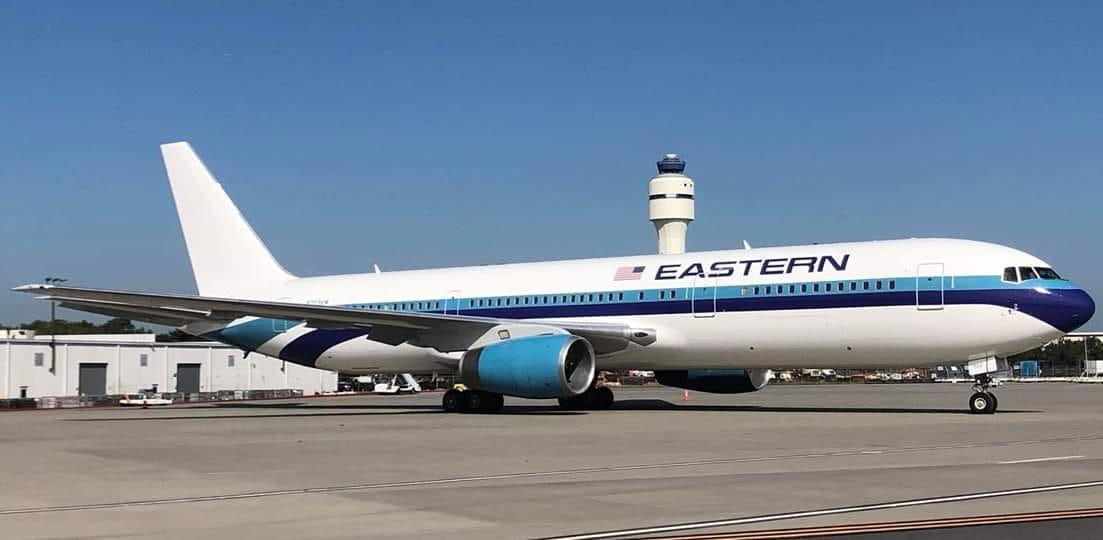Eastern Airlines, led by Foster alumnus, rescues thousands of Americans stranded abroad by pandemic

An Eastern Airlines repatriation flight boarding Americans stranded by the COVID-19 pandemic in Haiti.
Say you had launched a startup international airline, with eight planes running charters and a single commercial route, just a few months before a global pandemic grounded flights around the world, leaving thousands of Americans stranded far from home. What would you?
If you were Steve Harfst (BA 1986), the president and CEO of the new Eastern Airlines, you’d go and get them.
Since March 13, Eastern has done just that, quickly and quietly repatriating more than 10,000 U.S. Citizens (and 12,000+ people overall) who found themselves marooned by travel bans and quarantines in countries across Latin America—where Eastern has a foothold and plans to grow.
This improvised commercial airlift, coordinated with the State Department and local U.S. embassies, is a mission of mercy, first and foremost. But it’s also good marketing, a mettle-proving opportunity for a dynamic little airline with big aspirations.
“We were well-positioned to step up the plate and provide this essential service to Americans who would otherwise be stuck overseas,” Harfst told FOX Business in early April. “This is about efficiency and speed—which the large numbers of passengers we’ve brought home attest to.”
Born to fly
Mission is nothing new to Harfst. After earning his bachelor’s degree from the UW Foster School of Business in 1986, he traded a typical career path to serve his country—and follow a lifelong dream of learning to fly.
Commissioned in the U.S. Navy, Harfst graduated #1 in his class at flight school. As a Naval aviator, he served the rest of his decorated 10-year career in the cockpit of the F-14 Tomcat, logging 38 combat missions and 227 aircraft carrier landings, and nearly being selected to fly with the legendary Blue Angels.
His return to civilian life did not mean an exit from aviation. Harfst went to work for North American Airlines in 1996. And he was well-equipped to lead in a different context.
“The chain of command is a little bit looser in the private sector,” he says. “But the whole concept of taking care of your people, putting others first, and not to mention grace under pressure—it’s directly translatable to business. When you combine that with a solid educational background, it’s a really powerful combination.”
Over the next decade, Harfst rose to chief operating officer as North American doubled in size.
Game for a new challenge, in 2006 he became COO of the Delhi-based startup IndiGo, and helped build the nation’s largest and most successful airline from the ground up.
He followed with stints as president and CEO of USA 3000 Airlines, COO of Allegiant Air, president and CEO of eJet, and an executive consultant to Propellor Airports and Encompass Aviation, leading the development of Paine Field’s new passenger terminal.
Starting over, from scratch
Harfst joined Eastern Airlines as president and CEO in 2019. His challenge? Only to relaunch the remnants of a carrier just emerging from Chapter 11 bankruptcy. Eastern was, for all intents and purposes, a startup, with eight Boeing 767s, 200 employees and a familiar name licensed from an artifact of commercial aviation’s glamor days.
The old Eastern Air Lines, before its 1991 dissolution, once ruled the skies with TWA, United, American and Pan Am.
 The new Eastern Airlines had its work cut out before returning to that level of cruising altitude.
The new Eastern Airlines had its work cut out before returning to that level of cruising altitude.
Harfst inherited a glorified charter service. But he set the company on an ambitious international strategy to serve—with demand-driven frequency—secondary markets in Central and South America that are underserved to the United States.
Eastern’s inaugural route, from Guayaquil, Ecuador, to New York, began service in January. A second route, from Guyana to New York, was set to launch March 19.
Plans changed when, two days earlier, both countries declared states of emergency and closed their airports to international flights.
Mission critical
The same thing was happening everywhere. By mid-March, the novel coronavirus was spreading like wildfire across the Western Hemisphere and dictating travel bans and lockdown orders that left air travel at a standstill.
Rather than hunker down, Harfst stepped up to the challenge. He contacted the U.S. Department of State to offer Eastern Airlines’ help in repatriating American citizens who were stranded anywhere near its just-established territory. State forwarded the offer to embassies across Central and South America. “And our phones started ringing off the hook,” he says.
Temporarily, Eastern Airlines took on a new mission: to go boldly wherever there is a critical mass of displaced Americans and bring them home.
Out of thin air, Eastern conjured routes to countries scattered around Latin America, including Argentina (EZE), Bolivia (VVI), Brazil (GRU), Ecuador (GYE), Grenada (GND), Guatemala (GUA), Guyana (GEO), Haiti (PAP), Honduras (SAP), Panama (PTY), Paraguay (ASU), Peru (LIM), El Salvador (SAL) and Suriname (PBM).
“We created this out of nothing,” Harfst says. “We had no infrastructure in any of these locations. So once we got the green light from an embassy, we were on the phone with the local airport coordinating with ground handlers, fuelers, caterers, cleaners to set up the support infrastructure you take for granted when you go to a familiar airport terminal.”
All of this has happened—and continues to happen—at supersonic speed. Once approved, Eastern posts a flight to its website. Passengers book directly. And, within 36 hours, an empty plane arrives and boards them for non-stop service to Miami (MIA) or Atlanta (ATL) or Houston (IAH) or Los Angeles (LAX) or San Francisco (SFO) or Salt Lake City (SLC) or another North American destination.
Harfst is proud to offer these flights at no cost to the U.S. government. Passengers generally pay less than $1,000—a steal for a last-minute international flight in a world turned topsy-turvy. This generates just enough revenue to cover the operation’s expenses (especially since many of these relief flights operate far below capacity).
“The complexity of this operation is incredible,” he adds. “People are key. We have a small but amazing team that has worked around the clock to make this happen when they could be staying home and safe with their loved ones. It’s inspiring what our people have accomplished.”
Where to next?
How this foundational episode will impact the nascent airline’s future remains TBD. Harfst believes the effort has been well worth the cost. A Navy man, he’s fond of saying, “you can’t steer a ship that isn’t moving.”
Eastern is certainly moving.
And by filling an acute but temporary need, it may also have expanded long-term opportunities in overlooked cities peppered across Central and South America. These markets suddenly look much more familiar.
 “This is an extraordinary time for everyone. It certainly has turned our industry upside down,” Harfst says. “Nimble companies with solid balance sheets and good teams can react quickly in dynamic markets and take advantage of opportunities much more quickly than larger, more bureaucratic companies. I think we’re going to do well coming out of this period because of our ability to move quickly and react and adapt.”
“This is an extraordinary time for everyone. It certainly has turned our industry upside down,” Harfst says. “Nimble companies with solid balance sheets and good teams can react quickly in dynamic markets and take advantage of opportunities much more quickly than larger, more bureaucratic companies. I think we’re going to do well coming out of this period because of our ability to move quickly and react and adapt.”
As for his untested airline? Now it has been tested—and passed with flying colors. Not that he’s bragging.
“This is a time to be quiet and humble. We’re building our reputation, working on taking care of today,” Harfst adds. “But once this pandemic is over, we think our opportunities are going to be considerably larger than they were three months ago. We have pretty strong aspirations. We want to grow into a formidable airline. But you have to start somewhere.”
Lessons from IndiGo
When Steve Harfst was building IndiGo from a tiny startup airline into the powerhouse it is today, he realized the importance of installing a bedrock culture of accountability into the company DNA. “We knew that you can’t micromanage the kind of growth we were aiming for. Once the core team saw that our culture was working, they believed it and internalized it and then drove it,” he says. “Get people to believe in your vision, your culture, your strategy and how to execute on it—and then let them go and do it. That’s how small companies become successful.”
1 Response
Leave a Reply
You must be logged in to post a comment.





I flew Eastern decades ago from Atlanta, hoping they might make it through bankruptcy. That didn’t happen, but I am happy to see the Eastern name back in the skies again. Best of luck to you.